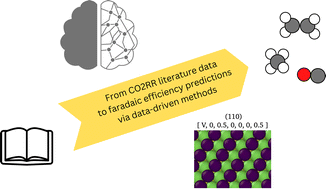What do we talk about, when we talk about single-crystal termination-dependent selectivity of Cu electrocatalysts for CO2 reduction? A data-driven retrospective†
Abstract
We mine from the literature experimental data on the CO2 electrochemical reduction selectivity of Cu single crystal surfaces. We then probe the accuracy of a machine learning model trained to predict faradaic efficiencies for 11 CO2 reduction reaction products, as a function of the applied voltage at which the reaction takes place, and the relative amounts of non equivalent surface sites, distinguished according to their nominal coordination. A satisfactory model accuracy is found only when discriminating data according to their provenance. On one hand, this result points at a qualitative agreement across reported experimental CO2 reduction reactions trends for single-crystal surfaces with well-defined terminations. On the other, this finding hints at the presence of differences in nominally identical catalysts and/or CO2 reduction reaction measurements, which result in quantitative disagreement between experiments.



 Please wait while we load your content...
Please wait while we load your content...